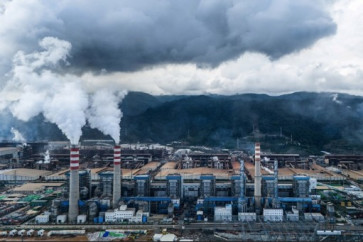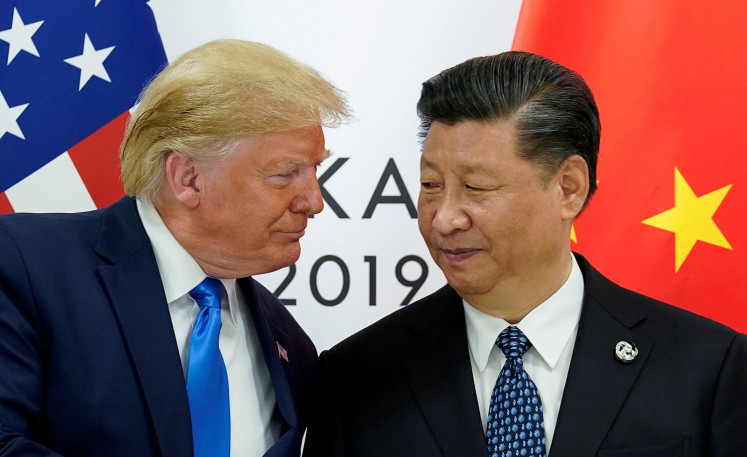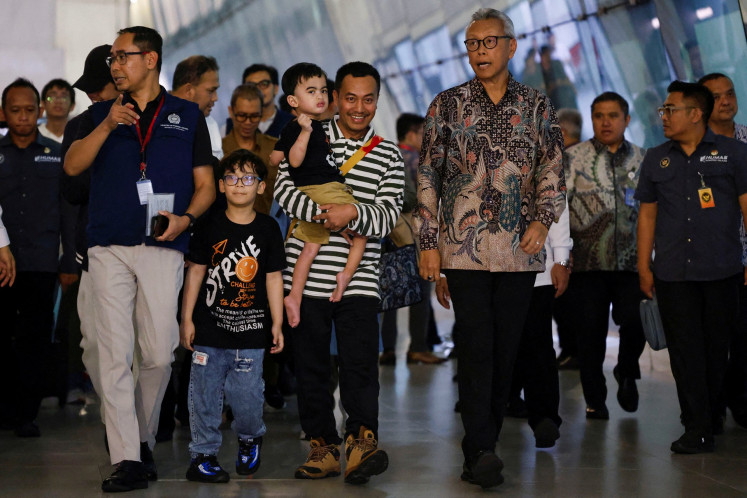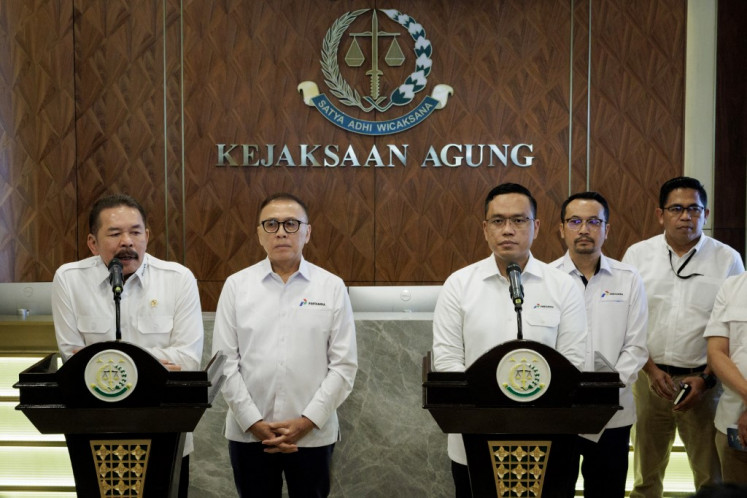Popular Reads
Top Results
Can't find what you're looking for?
View all search resultsPopular Reads
Top Results
Can't find what you're looking for?
View all search resultsAditya Novali’s country in oscilliation
Warriors of Change, kinetic machine, silver plated copper, wood cement, aluminum, 122 x 22 x 47 cmThe solo exhibition of Indonesian artist Aditya Novali (b
Change text size
Gift Premium Articles
to Anyone

W
span class="caption" style="width: 398px;">Warriors of Change, kinetic machine, silver plated copper, wood cement, aluminum, 122 x 22 x 47 cmThe solo exhibition of Indonesian artist Aditya Novali (b. 1978), now on show at the Jakarta Art District, marks his stunning ability to visualize depth of thought with evocative works of art using various mediums at the same time.
Looking at Aditya’s art evokes reflection on larger themes of history, memory, transition and passage, of mourning and of the future of this nation.
Unlike many artists who have bemoaned the sorry state of the country and its leadership, Aditya — without any pretention — delves into the very core of the issue.
Not focusing on just the social or political but on the overall state in which the nation and human existence finds itself at the present time, the works comprehensively reveal a world, as the artist sees it, so utterly haunting that the sheer sight of it must fill anyone watching with a penetrating sense of dark foreboding.
There is The Chaos, featuring the moving and shifting of Indonesia’s islands in an aquarium; The Process, featuring red wax dripping from the shapes of those islands; and The Contemporary, with its disintegrating features. With the installations Metropolitan Landscape, Metropolitan Monument, Unrepresentable Freedom and Silent Scream, where dark vistas without a single human being suggest the overall neglect of human existence in today’s society, Aditya’s premonitions for his country run deep. The sharing in these evocative works of art has never been so sublime and thought-provoking.
Entering the exhibition, one is first treated to large installations to be played with. Each is set on a base to appear like a large cupboard, with beautifully crafted “doors” 50 centimeters high and between 15 and 30 centimeters wide. On closer investigation, they are made with bars.
Rotatable, each has three sides, which to see only needs a little push on the facade or any of the sides. Each side can be a miniscule landscape or object, painted on canvas or sculptured. Pushing the “doors” of Metropolitan Monument, one may see the tools that punish criminals with death like the guillotine, the electric chair, the strap that some have used to take their own lives out of sheer despair, or they may see miniscule leafless trees, which if they do have leaves appear as sick leaves, colored in a green from which all freshness is gone.
Other images include a bare branch placed on what looks like a grave, a graveyard or withering trees — all shrouded in darkness — with the lighting only strengthening the accent on the dramatic. In Metropolitan Landscape, the shades are lighter but the images are as macabre.
The same goes for Unrepresentable Freedom and The Silent Scream from the series “A House Is Not A Home” or in the rotatable painting The End One Day.
While the aforementioned installations engage in the effects on the human condition, the stirring series “Identifying Indonesia” deals with the physical landscape of the Indonesian republic, which is affected by confusing political, social and natural upheavals.
In an aquarium, images of Indonesia’s larger islands made of cut mirror plexiglass chaotically dance, float and shift amid the turbulence of the water in the aquarium. Appearing fun and playful, the work is based on the uncertain situation that prevails in regions even after they obtained autonomy.
Next to this piece is The Process, which suggests the bloody violence that has ravaged the country and its people. In a box hanging on the wall, the red wax covering the shapes of the Indonesian islands made of metal rods is melding under the electric heating of the rods, “unveiling” the islands as the red wax drips to flow from the islands’ images like blood flowing in violent acts that have ravaged the country and its people.
As disintegration tends to increase, ultimately the islands will not be recognizable anymore. This is visualized in an interactive work, where pushing unidentified buttons evokes the emergence of dotted light points that only eventually may multiply to form a recognizable glimpse of what once was the map of Indonesia, depending on how many buttons are correctly pushed.
In the middle of the room, right in front of these works, are two empty edifices made of transparent copper frames. Taking the shape of the state palace in Jakarta, it is a metaphor for the absence of leadership.
But looking back in history, Aditya finds that the creating of the nation has always demanded victims.
The History shows a field of skulls on which the islands are painted. And as if he wanted to keep up hope, Aditya created a kinetic piece where the fallen dead bodies of heroes in the field keep moving like hiccups, signaling that the spirit of change will survive.
A huge structure titled Asian (Un)Real Estate Project shows how the buying and selling of real estate has been increasing in Asia. Yet, the question remains whether those high-rise apartments have been beneficial to the human spirit.
Each of the 160 miniscule triangular apartments likens to a prison cell, offering space only for a single chair, a single bed or a single piece of furniture; no human figure is detected. Here again, Aditya reveals a profound concern for urban housing today as well as an incredible craftsmanship along with perfect attention to detail.
Aditya first came to public attention with his solo show at CP Artspace in 2004 in which he demonstrated his exquisite craftsmanship, but it was his innovation with rotatable paintings that broke new ground, and in 2011 he became one of the three awardees at the Bandung Contemporary Art Awards.
Refined and more elaborate, his current show tops all else and is a milestone in the Indonesian art scene.
“Indoscape: A ‘Geo-History’”
A solo exhibition by Aditya Novali
Organized by Canna Gallery
Curated by Jim Supangkat
Until Dec. 11 at Jakarta Art District,
Grand Indonesia, from 11 a.m. onward
— Photos by Carla Bianpoen









